Here’s an article I never thought I’d be writing — the history of play piercing and human pin-cushions, from 1885 through 1940, as collected from archival news clippings. I have spent the better part of the day reading story after story in historical archives about both sideshow performers who did play piercing, and people who seemed to do it for fun — sometimes with hilarious results — as well as the different ways that play piercing percolated into the mainstream via fictional prose and cartoons. It has been interesting to say the least. With the exception of cartoons, which I have placed at the very end of this article, I am presenting here, in chronological order a number of stories that caught my interest. You’d be amazed how many brief mentions and repetitions I’ve skipped over. I never would have guessed at how much the media of the time loved writing about this subject. It absolutely fascinated them! For all of these stories, if you want to see more than the excerpt that I have transcribed, just click on the scanned headline that starts the story to be taken to the original news clipping.
I hope you will find comfort and enjoyment in the fact that many of these stories could easily have been published today. We often fool ourselves into thinking we are the first people to have a set of unusual experiences, but a careful examination of history shows that even the oddest seeming things repeat themselves over and over ad infinitum.
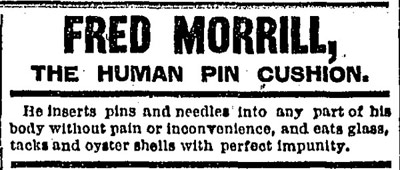
Note: This is a very long post, so it continues after the break. I hope it will be fun for history buffs, and that I have not made too many typos.

Frank De Leon, a New York boy, is a human pin-cushion, and sticks 500 pins and needles in his breast without pain to himself.
-Albion New Era, October 22, 1885
I have to admit that the humor in this next one is going over my head, but it’s illustrative of the fact that in 1885 the idea of “the human pin-cushion” was a part of the mainstream concept of the world.

“Did you advertise for a fat man?”
“Yes, sir.”
“Well, I’m after a situation, and I guess I’m fat enough for you. What do you want me to do?”
“It’s not a pleasant job, and I’m afraid you’ll not undertake it.”
“Oh, yes, I’m ready to do anything. What is it?”
“We want a man to act as a human pin cushion in our museum. The salary is a dollar a day, and you may have all the pins a liberal public sticks into you. Is it a go?”
“Yes–I’m going.”
-Steven Point Daily Journal, November 7, 1885
Note: I have to wonder if hte “Harry Leon” in this story is the same person as “Frank De Leon” in the earlier story? You will also note a trend in these stories, that of doctors having absolutely no idea what they’re seeing. Rather than just realizing that some people can handle needles, they look for problems in the nervous system or disease.

An interesting exhibition of mesmerism or physical phenomena was witnessed in the parlors of the American House yesterday afternoon. A number of physicians and prominent citizens was present, among whom were Dr. C. D. Ellis, Dr. Peck, Dr. H. J. Herrick, Mayor Gardner and John Kingsborough. The mermeric tests were conducted by Professor E. G. Johnson, a young man, who amused and mystified the gentlemen present, and fully demonstrated that he has a wonderful command over the minds of a certain class of people. Traveling with the professor is a young man named Harry Leon, who is styled “The Human Pin-cushion.” He was born without the sense of feeling, and is impervious to pain. He was stripped to the waist, and Professor Johnson immediately began to stick needles into his body, and fifteen or twenty were placed in his breast and left there. His cheeks, ears and tongue were then pierced through, and large needles driven through the fleshy part of his arms. The young man never winced while going through this trying ordeal, and asserted that he felt no pain whatever. The physicians present made several tests and were satisfied that the man was a peculiar phenomenon. He is healthy and good-looking, but has never been subjected to pain since birth. The professor then gave an exhibition of his mermeric powers.
[article continues] The next test was a peculiar one. A common sewing needle was produced already threaded, and the patient’s cheek, tongue and limbs were sewed together. The spectators shuddered at the sight, but not a muscle of the mesmerized man moved, and not a drop of blood followed the needle’s tracks.
-Iowa State Reporter, December 24, 1885

Louis J. Beck, a Newark (N.J.) butcher, aged 23, is the latest freak. He sticks needles through his cheeks, nose, tongue, lips, fingers and external tissues generally, making of himself a human pin cushion, without experiencing any pain or discomfort.
-Boston Daily Globe, January 29, 1889
This next one is about the same person, but with a little more detail.

Louis J. Beck, a human pincushion, recently gave an exhibition to a large audience in the office of a New York paper. He used two-inch needles, which he passed through his ears, cheeks, tongue, arms and legs. He then filled his breast with the needles. He shoves them into the very bone. The most remarkable thing about the performance is that little, if any, blood appears after the incisions. Beck is 23 years old and was born in Newark, N.J. He was formerly a butcher. His father is one of the largest wholesale butchers of Newark. The pincushion was finely attired in dark red costume and light leather slippers. He says that reputable physicians who have examined him say that he suffers from paralysis of the nerves. He has lost several needles while giving exhibitions, but they have all worked themselves out at different points of his body.
-Indiana Progress, March 6, 1889
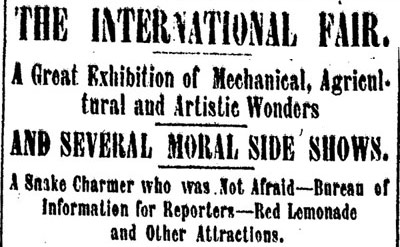 Brief Excerpt:
Brief Excerpt: Another curiosity is a troubled looking young man who poses as the human pin cushion. He sticks numerous sharp needles into his face, neck and breast, and each particular needle stands on end “like quills upon the fretful porcupine.” He presents a very peculiar appearance when his countenance bristles with needles, but he says they don’t hurt him a bit. He can lie about as well as the adertising managers of the fair.
-Bradford Era, September 9, 1889

The town of Corinth, Penobscot County, is proud in the possession of a young man who may truly be called a human pincishion. The remarkable Corinthian sticks pins and needles all through his flesh and jabs horseshoe nails into his breast without apparent pain. He also sticks needles through his chest and pulls them out of his mouth. He does this sort of thing “for the fun of it,” and never saw a dime museum in his life.
-Oelwein Register, March 27, 1890
As a point of trivia, best I can figure is that the address referred to in this next article is the current site of the National Education Association in Washington DC.

The “human pin-cushion” is the rather suggestive title applied to William Dudley, a short, coffee-colored man, who resides at 1211 Sixteenth Street northwest. Dudley succeeds in capturing a good many pennies, nickels, and dimes during the course of the day by frequenting bar-rooms and other resorts and converting his wooly head into a veritable pin-cushion. He never uses less than a full paper of pins at one exhibition of his skill, and the bystanders are permitted to drive these up to their heads in his cranium. He claims that they penetrate his skull and clinch on the inside, much after the fashion of a wrought-iron staple. Dudley is proud of his prowess, and takes evident delight in giving exhibitions and talking about it.
-Gogebic Advocate, July 16, 1892

He inserts pins and needles into any part of his body without pain or inconvenience, and eays glass, tacks and oyster shells with perfect impunity.
-Boston Daily Globe, May 28, 1893

A drunken man arrested in Lawrence last night, surprised the police by telling them he was a human pin cushion. He had been amusing a crowd by sticking pins in his face. When taken in he had 25 sticking in his face, only the heads being visible.
Several were put through his ears. On the neck a line of pins could be seen, only about a quarter of an inch being exposed to view. He was free from blood save one place on his right ear. Other pins were put through the skin on various parts of his face only the head and point being visible. He said he could “swallow horse cars, electrics, steam cars and crowbars.”
-Boston Daily Globe, October 13, 1894

Sheboygan Falls has a freak in the person of S. C. Plece, son of Levi H. Plece, an old resident. The young man calls himself the human pin cushion, and gives exhibitions of having needles and pins passed through his arms, legs and tongue and allowing his hands to be nailed to boards. He seems to suffer no pain and jokes and laughs while the experiments are made. Physicians are greatly interested in the case.
-Oshkosh Daily Northwestern, January 6, 1899
This next story is quite disturbing, and I wonder what the truth of it is.
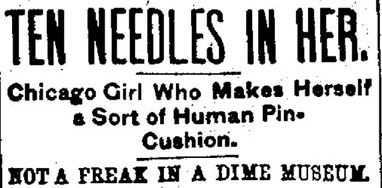 Two Ways of Accounting for the Presence of the Needles, One Being That of Penitence for Sins, the Other Carelessness
Two Ways of Accounting for the Presence of the Needles, One Being That of Penitence for Sins, the Other Carelessness
At least seven and probably more needles are embedded in the stomach of Lena Walshlaeger, aged 19, residing at 314 Center avenue. Her physician has already removed three needles from the young woman’s body, and another operation will be performed soon. The needles have, it is believed , been in the stomach for two years. The girl accounts for the presence of the bits of steel in an unusual way. She says that before her widowed mother left Germany some two years ago she put her in a convent. The young woman admits she was a rather unruly student, and says that as a punishment the priests told her to prick herself with needles. Not being brave enough to inflict this pain upon herself, the girl says she filled a belt full of needles and fastened it about her body in such a way that energetic movement cased the needle points to prick her. The girl believes that some of the needles from the belt entered her body and worked their way into the stomach. She ran away from the convent at last and followed her mother, who had come to Chicago.
Put Her Under the X Ray: Miss Walshlaeger frequently suffered excrutiating pain and doctors treated her with no good results. A few months ago she went to live with the family of Dr. George M. Silverberg. He decided the pains came from a foreign object in the stomach and performed an operation. He was astounded to find a needle in the stomach. The bit of steel had turned black, but was not at all rusty. The pains continuing, another operation was performed last Monday and two more needles were removed. The young woman was then put under the X ray, and to the astonishment of all the negative showed five more needles, and when the negative was developed seven of the bits of steel appeared in the picture.
Neighbors Doubt Her Story: Miss Walshlaeger has now recovered entirely from the operation and is ready again to undergo another ordeal. Mrs. Silverberg rather casts doubt upon the girl’s convent story. She says that if the young woman had used more care in pinning on her clothes she might not now be a sufferer. “I have to watch her closely even now,” said the doctor’s wife, “to see that the needles she uses in pinning on her skirts are placed so they will not enter the flesh.” Miss Walshlaeger is a well-appearing young woman with brown hair, good features and figure.
-Waterloo Daily Courier, January 14, 1899
In this next case, it appears that a human pincushion put himself at risk because doctors assumed his ability to handle the pain of the needles came from leprosy! Not that doctors are terribly good at understanding body play today, but at least we don’t get accused of being lepers.

It is reported here from Chicago, that Sydney Pierce
[Great name -Shannon], the human pincushion, is believed to be a sufferer with leprosy. He is a former Sheboygan Falls young man and entered upon the career of making his living by permitting pins and tubes to be stuck into his body in this city a few weeks ago. He went from here to exhibit himself at a museum in Chicago. Physicians of this city seem to think that the young man has some nervous trouble, which caused him to be impervious to pain.
The report is that the man’s arms turned black where they had been punctured and blood trickled from his face where the tube was inserted to burn the gasoline from his mouth. While here he gave only one exhibition a day and at Chicago he showed what he could do several times a day. It is claimed that Pierce now lies at the point of death in a Chicago hospital, where examinations of prominent physicians resulted in a belief that the patient is a leper.
Before he left here he was told by doctors that the exhibition of his feats would in no way cause him injury.
-Fort Wayne News, March 3, 1899
This is a follow-up.

The parents of Sydney Pierce, the so-called human pincushion, deny that he is a leper. His home is in Sheboygan Falls and he is giving exhibitions of himself in Chicago. A letter from him says that the doctors are still at a loss to understand his absence of pain.
-Oshkosh Daily Northwestern, March 4, 1899
This story reminds me a little of the “mystery needles” above, but in this one I’m quite certain it is a person who is play piercing in a traditional “self harm” context and afraid to admit it, and doctors not understanding the issue. Actually the size of their blinders are frankly hilarious.

The medican fraternity of Elwood is greatly interested in a most unusual case, and is at a loss to satisfactorily explain its peculiar conditions. A young woman of that city has called upon surgical skill to have removed from her arm needles, pins and other small articles that have, during the past few days, worked their way to the surface, and the point that is causing all the conjecture, is how they got into her arm. She is the daughter of Mr. John Turner. She is about nineteen years old. Saturday morning Miss Turner called at the office of Drs. Newcomer & Dick and complained of the soreness of her arm between the elbow and shoulder.
The physicians made an investigation and removed a needle. The pain was not alleviated, and Monday morning Miss Turner returned. Two needles were taken out, in the evening she went back and six more were removed. A hair pin and the tooth of a comb were also taken from the arm. Since that time the girl’s father has removed a brass pin, and there are indications that all of the articles beneath the surface are not yet removed.
The young woman cannot throw any light on the manner in which the articles found resting places in her arm nor can her parents solve the mystery. It is possible that they might have been swallowed when she was a small child. This theory brings up the question as to how they passed from the stomach to the arm, and why all of them should work out on the same portion of the body.
-Logansport Reporter, March 2, 1901

The human ostrich is dead. He ate too many hat pins. A most interesting post mortem was held by the coroner. The “ostrich” was Robert Naysmith, formerly a peddler, aged thirty-four. For ten years he has been traveling as a sideshow freak, swallowing nails, glass, ladies’ hatpins, tacks, needles, and any old thing given him.
A few weeks ago he had to go to hospital. There he died, and last week’s inquest showed that he had swallowed too many indigestible hat pins. Thirty of these and a few brass-headed nails were found in his liver and kidneys.
-Washington Post, July 15, 1906
This story is not actually about a human pin-cushion, but it shows what an awareness of the profession there was at the time. Also pretty funny courtroom theatrics.

A human pin cushion was on exhibition in Criminal court here recently when Martha Geyyer, suing the city of Pittsburgh for $10,000 damages
[about a quarter million dollars in today’s money] because she fell through a board walk maintained by the city, was brought before the judge and jury by counsel, who proceeeded to run a needle through her flesh. The woman apparently felt no pain.
A match was struck and a doctor was about to burn a blister on the arm when the court said he guessed that would not be necessary. A verdict has not been reached.
-Advance Argus, July 25, 1912
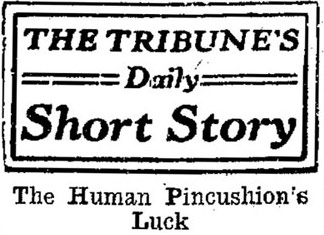 Sorry, I’m not transcribing this one because it’s very long but it’s a fictional story (many papers of the time included short fiction). However, I loved the description that starts it:
Sorry, I’m not transcribing this one because it’s very long but it’s a fictional story (many papers of the time included short fiction). However, I loved the description that starts it:
It was plain to every spectator of the side show of the Collin’s Colossal Consolidated Circuses that Prof. Matt, the human pincushion, was greatly peeved about something. Instead of pushing the needle, hat pins and other sharp instruments into his arms, legs and face gently, as was his wont, he was jabbing them in viciously, as if trying to get even with himself for something. The side show manager made no attempt to stop him, because, if anything, it added interest and excitement to the act.
-La Crosse Tribune, March 17, 1914
I’m sure the idea of piercing oneself over and over with random dirty needles brought in my complete strangers is absolutely horrifying to people these days!

After traveling for years with Barnum & Baily, and being featured in the side show as the “human pin cushion.” Cornelius Shoep has come home to Grand Rapids, a physical wreck from the results of the peculiar stunts he did in his act. Shoep was accustomed to take pins from persons in the crowd in front of his booth and run them into his flesh until only the heads remained in sight. He evidenced no signs of pain and no blood followed the withdrawal of the pin. Shoep’s body is covered with dark scars. He was fequently compelled to take to his bed from sheer exhaustion, and now it is said blood poisoning has developed in a virulent form.
-Coshocton Daily Tribune, June 3, 1916
This is a funny set of stories about a guy that must have been completely hilarious to deal with.
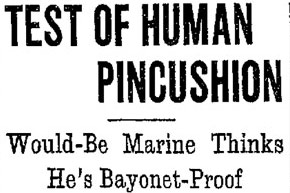
Something wholly novel in the way of candidates for enlistment drifted into the Marine Corps Recruiting Station from Scollay sq this morning. He was a human pincushion from Middleboro, by name Artois Crawforiski, with emphatic red hair and an ardent desire to hitch a tin can to the ultimate and penultimate syllables of his label.
Artois brought a hat pin up the stairs with him and handed it to 1st Sergi Doherty, with the request that his bullet proof qualifications be tried out.
Sergt Doherty obliged. P-l-i-s-h! in a spot where nature had been bountiful to Artois
[Please tell me is a euphamism for his penis! -Shannon], but no response from him save a low, satisfied chuckle. Then he volunteered to defy a bayonet, but Sergt Doherty threw up his hands and passed the applicant along to Dr W. Randolph Angell.
The examining surgeon found nothing the matter with him but a heart which murmured too much. So Artois went away from there, headed in the direction of a nearby hotel, where, through some ingenious device, it was thought he might be able to effect the etymological change he so desired.
-Boston Evening Globe, August 28, 1917
This is a funny expansion on the story you just read.
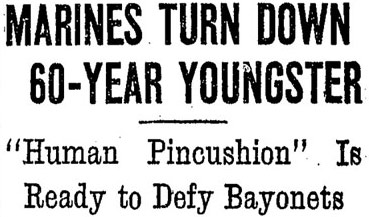
“I’ve seen 60 Winters, but it seems like only 20 Summers, and they say a man is only as old as he feels,” he announced to Top Sergt Doherty, on climbing the stairs to the Marine Corps recruiting station yesterday afternoon and applying for enlistment.
But the heartless top sergeant turned him down–politely, yet firmly–just as he did, a few hours earlier, a Middleboro man who announced himself a human pincushion and brought along a hat pin for the examiners to probe him with, when offering to defy German bayonets by fighting in the front ranks of “The Soldiers of the Sea.”
-Boston Daily Globe, August 29, 1917
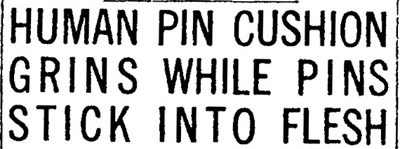
Found: The human pin cushion!
“I could lick Jack Dempsey, heavyweight champion–if I were a heavyweight–and with a few months’ training I could lick Harry Greb, middleweight champion of the world.”
Thus did Charles J. Adams, of Bridgeport, Conn., unburden himself here while he stuck heavy pins deep into his flesh–arms, legs, face and other parts of his anatomy just a little demonstration of his ability to take punishment.
Being a little skeptical, the correspondent inspected the pins with due care and found them to be the usual variety. Adams asserted he has been able to stick pins into his flesh since early childhood.
“Physicians say I am minus many of the nerves possessed by the average person that register bodily pain to the brain,” Adams explained. “I don’t know why it is, but I know I can laugh while my body is being tortured.”
-Sandusky Register, October 27, 1923

William Hume of Blyth, London is a human pin cushion. He can be stuck with pins anywhere without their hurting him. Pins can be stuck in his arms, his jaw, legs or ears, and he’ll keep them all day without them hurting. Doctors cannot explain his case, because he is said to have the same nerve system as an ordinary human.
-Laredo Times, April 27, 1930
This story is interesting because not only is it a bio of a pin cushion, but it also describes the first reference to scarification in modern America that I’ve seen.
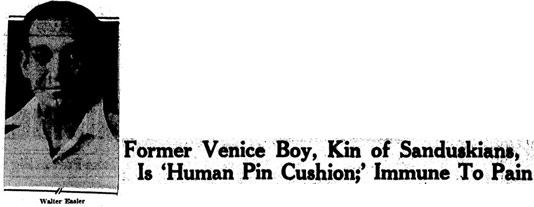
Remember that old corncob which used to nestle in the middle of your back when you slept on a dusk mattress? Remember the expression on needles and pins? Well, neither of these expressions has a meaning to Walter Easier, Venice boy, now of Lorain, who dropped into Sandusky for a visit with newspapermen this week.
And–mosquito bites are not felt by this “human pin cushion”–as they call him in Lorain. He is pictured here with a hat pin stuck through his cheeks.
Walter, as he introduced himself, is a brother of Clarence Easier, 1025 Jay-st, of this city. His parents, who have died since his birth in 1906, lived in Venice. Walter is at present making his home in Lorain with a sister, while a second lives in Cleveland. He can stick needles and pins into his anatomy waithout the slightest tinge of pain.
Doctors who have examined Easier say that this strange ability of his is caused by what is known as sensory anasthesia–that is, the nerves which carry the sensations of heat, cold and pain to the brain do not function.
“I surely spent a happy childhood,” Easier grinned. “I could do anything I wanted and get away with it because a spanking meant nothing in my young life. It didn’t hurt at all. One of my father’s greatest problems was to figure out ways to punish me other than the usual lambasting that the average father’s son receives for misbehavior.”
Easier rolled up his sleeve to show to some of the skeptics that is true. The dim outline of the initial, “W. E.” could be seen. “These,” he explained, “were made in school with a penknife, just to show the kids that it didn’t hurt”–and he added, “I was expelled for being a sideshow artist during school hours.”
He declared that an ice pick, when inserted into his body, draws blood, while a darning needle, or an object of like character, does not draw blood.
Although at first this would seem to some to be a great favor, it also carries an acute danger with it–that of warning of appendicitis or acute indigestion in which cases of primary warning is great pain.
He told of several times when he suffered injuries of which he was not aware until later when informed. Once a finger was cut and he was not aware of it until seeing blood. On another occasion he suffered a bad cut in his back that required several stitches.
In both cases it was necessary for them to tell him he was injured.
He also told of going to a circus and challenging one of the artists who was sticking pins into his body. Easier duplicated the feat and had a contract offered to him, but he refused, he said.
He also appeared on the stage, sewing up his mouth with needle and thread. Several women fainted and the manager offered him a job but he refused, declaring he is not fond of performing. However, since the death of his mother he is considering going into the show business.
Recently when representatives of the Universal News Reel Service company of Los Angeles visited Lorain they took pictures of Easier.
-Sandusky Star Journal, July 20, 1931
This story is very funny!

A Kiel young man who went on the stage at a carnival show at the fair last week to help demonstrate that a “pin sticking” act was not a “fake” fainted and had to be carried from the tent, according to Kiel reports.
The Kiel man and a friend were spectators at one of the shows and watched a man billed as the “human pin cushion” jab pins into his arm. Apparently the crowd suspected a fake of some kind. The performer came down into the audience and the Kiel man volunteered to become part of the act to the extent of trying a few easy thrusts of a pin into the performer’s arm.
Encouraged by the freak the Kiel man gave the pin a lusty jab and sank it in the performer’s arm. The volunteer does not remember what happened after that. When he came to he was outside the tent and his friend was fanning him with a newspaper.
-Manitowoc Herald Times, August 29, 1935
Not sure how you can crucify yourself, even if you don’t mind the pain?

George J. Timmerman, 39, had nail holes through his hands and feet today as the result of a “crucifixion” which Sheriff S. C. M. Thomas declared faked for notoriety or sympathy.
Found by Friend
The jobless bricklayer and carpenter who was employed until recently on the cross-Florida ship canal was found by a friend James M. White, shortly after dawn yesterday in a wooded section near where he lived in a housecar.
Seemingly semi-conscious, Timmerman told a rambling story about being pounced upon by a group of men and nailed hand and food to an improvised cross.
He stuck to that story through a day of questioning but investigators discounted his claims.
“He is faking,” said Police Chief J. H. Spencer, “he is seeking either notoriety or sympathy.”
Although in a hospital for treatment, Timmerman showed no outward signs of great pain from his experience which also included having his lips stitched together.
No Bones Broken
These was little blood on the makeshift cross when Timmerman was found, but police officers who pulled out the spikes said there was some bleeding from his hands. No bones were broken by the big nails which pierced his hands.
White was held in jail for further questioning today. No charge has been placed against him.
Officers investigated reports that Timmerman had given exhibitions of a “human pin cushion” allowing pins, needles and nails to be punched through his hands, lips and other parts of his body.
-Wisconsin Rapids Daily Tribune, March 19, 1936
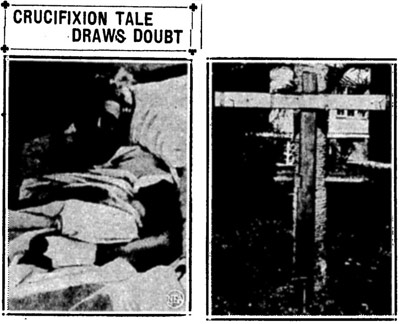
George J. Timmerman, 39, a jobless bricklayer, is pictured above at Ocala, Fla., his bandaged hands mute evidence of the nail holes in both hands and feet. Below is the crude cross on which Timmerman alleges a “gang” crucified him, an ordeal from which he was rescued by a friend. Police called the crucifixion a hoax, charging Timmerman is a “human pin-cushion.”
-Sandusky Star Journal, March 23, 1936
Oops! That’s embarassing.
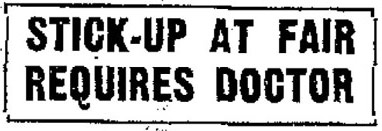
A man was “stuck up” at the Cass County Fair Wednesday. No crime was charged, however.
“The human pin cushion” who entertains fair patrons by sticking pins in his face, yesterday injected a pin in a vulnerable spot on his cheek. The ensuing pain sent him rushing to the First Aid Bungalow of the Health and Welfare Association, where Mrs. Julia Haner, city nurse, and Miss Genevieve Shaw, county nurse, are in charge.
Dr. E. A. Spohn, county health officer was present and treated the victim, assisted by the two nurses.
-Sandusky Star Journal, March 23, 1936
And another oops! This was the 1937 version of “Jackass” I guess.
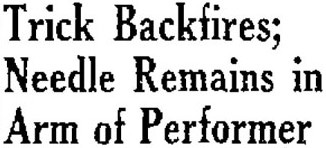
Henry Harsch, mail room employee of the Daily Hawk-Eye-Gazette prided himself on one trick which he performed for the edification of his friends, whenever he could obtain the floor. It consisted of pushing a threaded needle full length into the fleshy part of his arm and withdrawing the same with the thread without shedding blood. The thread pulled out of the needle’s eye Sunday after he head performed the human pin cushion feat, leaving the needle imbedded in the flesh. He hurried to a hospital, where a surgeon in probing for the needle broke it off, and it was necessary to make an incision to find and remove the broken piece. It required 10 stitches to close the incision and Henry says the trick is “out” from now on.
-Mucatine Journal and News Tribune, January 11, 1937

Charles Pereckinsky, 23, of Old Forge, known in the circus and carnival world as the “human pin-cushion,” died at his home, following a short illness.
Pereckinsky, who worked for shows under the name of Charles Perkins, and earned his livelihood by piercing his skin with needles and pins and sewing buttons to his flesh without evidence of pain, recently offered his body for sale to medical science. There were no takers of the unusual offer.
-Chester Times, April 19, 1937
This next story flushes that out a little, explaining how much he was demanding for his body and how someone so young might have died.

Charles Perechinsky, 23, “human pin cushion,” who recently offered to sell his body to science for $4,000, died Saturday.
Perkins, as he was known professionally, was able to pierce his skin with pins and needles and sew buttons to his flesh without showing pain. A hip injury as a child resulted in 23 operations. He traveled with a sideshow until he became ill recently.
-Titusville Herald, April 19, 1937
 A brief excerpt from this article describing the festival:
A brief excerpt from this article describing the festival: The fourth act presented “Believe It or Not” stunts by Henry Chouinard who gave an amazing performance of hair-raising acts “read about but seldom seen.” He first represented a human pin-cushion, sticking hair pins from six to 12 inches long through all parts of his body; next the human volcano act, in which the young man devoured lighted torches; and the last feature, in which he swallowed knives and swords, some as long as 15 inches, and in which he chewed up razor blades and glass which he proceeded to swallow. Henry Chouinard is known to undergo three operations a year, for the removal of nails, spikes and other items from his body. On one occasion, a pair of shears was removed, after an act which has been performed by only one other human being, that person having died last year from the effects of the act.
-Lowell Sun, July 25, 1937
“Got so hilarious” is a great expression for “trashed”. And you know what? I don’t think there is a cooler job description than “superintendent of speed”!
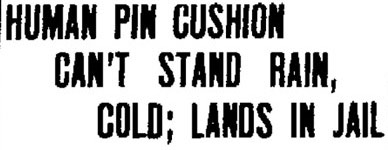
James Upton, 22, of Detroit, who is appearing with the carnival at the fair as the “human pincushion,” can take a lot of self-inflicted punishment, but when he took a few drinks to shake off the gloom of Monday evening’s dismal weather, he got so hilarious that it became necessary to call county police. They said they found Upton attempting to ride away on a bicycle owned by J. Hiram Glass, the superintendent of speed. After spending the night in jail, Upton appeared before Municipal Judge S. J. Luchsinger on a charge of being drunk and disorderly this morning and was fined $10 and costs.
-Oshkosh Daily Northwestern, August 27, 1940
And now to wrap up, below from left to right are some related comics of dubious humor level that may or may not translate across the ages —
Mansfield News (January 18, 1902),
San Antonio Light (December 4, 1939),
Sioux County Capital (November 14, 1940), and
Capital Times (January 19, 1941).
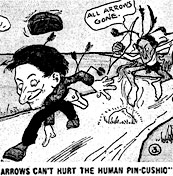

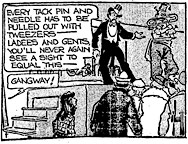

























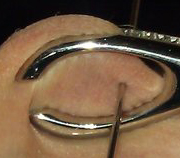
It’s been healing well, so far.